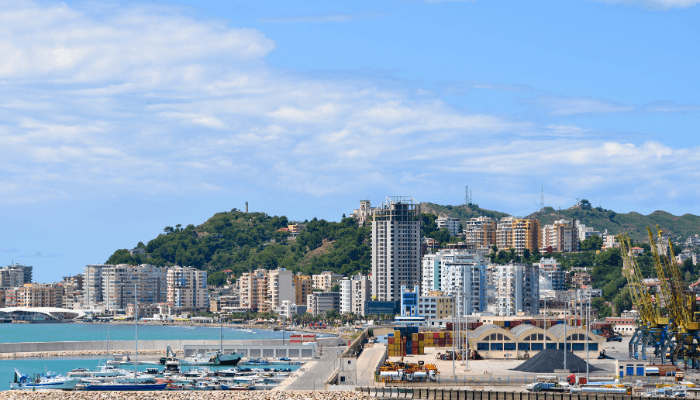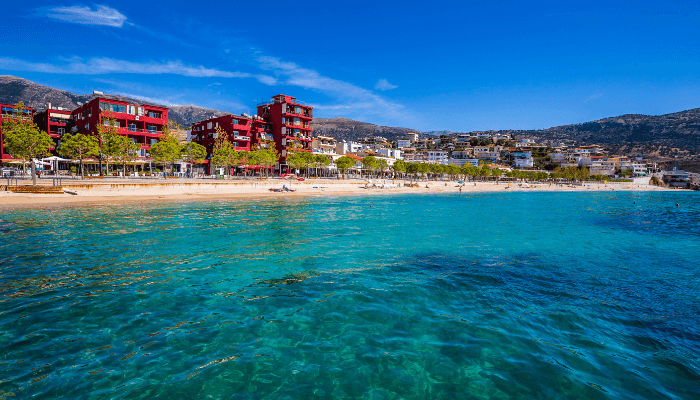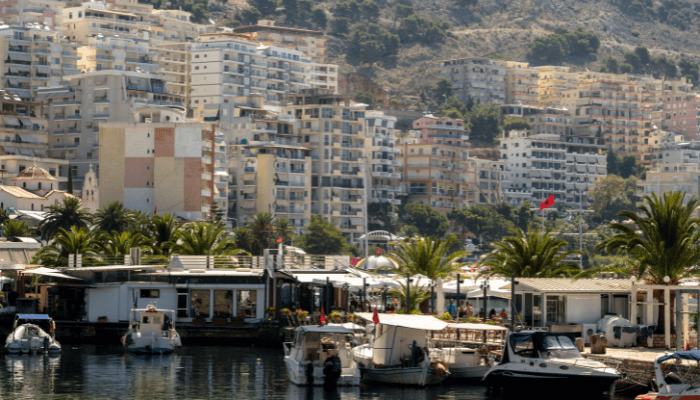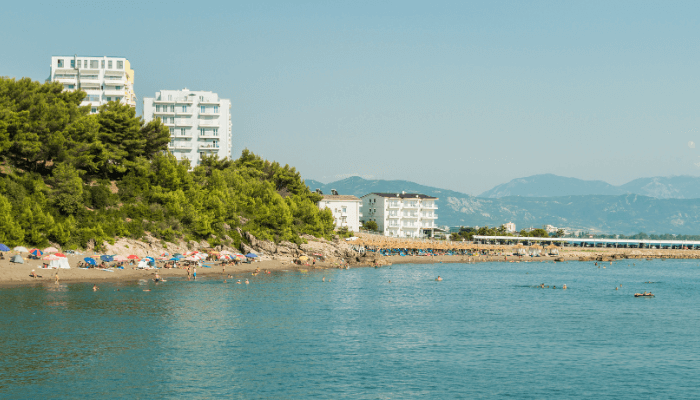4 Major Ports of Albania
Albania is a Southeast European country in the Balkans on the Ionian and the Adriatic Seas. It is a developed country dominated by the services sector, manufacturing, and tourism. In 2014, it recorded the 4th lowest unemployment rate in the Balkans.
Agriculture remains essential and employs a significant proportion of the population. Fruits like apples, oranges, peaches, cherries, strawberries and plums are grown, and potatoes, tomatoes, and onions constitute the main vegetables produced here.
Apart from these, meat, dairy items, aromatic plants and tobacco are also cultivated. Albania is a major producer of salvia, yellow gentian and rosemary. Albania’s fishing industry has great potential to generate export earnings as prices in the Italian and Greek markets are higher than in the Albanian market.
Agricultural produce, minerals, and metallic ores are exported through the country’s four major ports. Albania’s largest trade partners are Italy, China, Greece, Kosovo, the U.S. and Spain.
Mentioned in this article are the 4 Major Ports of Albania.
1. Port of Durres
Durres is the biggest port of Albania, situated at the northern end of the Bay of Durres, a body of water between Kalaja e Turres and Cape Durres.
The Port is made of an artificial basin between 2 moles, with a 183 m wide entrance with a west-northwest orientation. Many shipwrecks lie close to the access channel, which is 120 m wide and has a depth of 9.5 m. Hence, using tugboats is mandatory.
The Government of Albania plans to relocate the present-day Durres Port northwards to the Porto Romano area and construct a luxury marina at the current port area. This would boost tourism in the country.
Durres is also Albania’s largest passenger port and one of the biggest in the Adriatic Sea, handling almost 1.5 million passengers annually.

Port Infrastructure
The Port has ten berths and around 763 m of alongside pier space on the West Mole. A small harbour was constructed for fishing boats, and operations began in 2013. The port handles all kinds of cargo, including breakbulk and bulk cargo, general cargo, steel and non-ferrous products, RORO, palletised goods and containers. The port has warehouses for storing goods like timber, grains, reefer, and general cargo.
Approximately 603,000 tonnes of cargo and 770,800 passengers are handled at the port annually.
The Durres Port also offers regular cargo and passenger ferry services to Ancona, Trieste and Bari. Around 878,688 passengers and 259,175 vehicles were transported from this port on 1052 ferries in 2019. In the same year, 19 cruise ships carrying more than 4500 passengers visited this facility.
In 2019, a customs office of the Republic of Kosovo opened in the Port, simplifying the import of cargo to Kosovo and relieving the Vermica/Mornia border crossing.
Port History
The city of Durres and its port have a long history dating back to the Roman Era when it was called Dyrrachium. It was a vital military and naval base and became the western end of the Roman Road called Via Egnatia, leading to Thessalonica and Constantinople.
The famous Roman emperor Caesar Augustus declared it a free town after the Battle of Actium. It was populated by the veterans of his legions.
In the 4th century, it was made the capital of Epirus Nova province. Struck by an earthquake, its defences were destroyed and subsequently rebuilt by Anastasius I, who also strengthened its city walls, building the strongest fortifications in the region. Though portions of these ancient defences remain, much of them have been reduced over the centuries.
The city suffered from barbarian invasions and later Bulgarian attacks. It was unaffected by the fall of the Western Roman Empire and prospered under the Byzantine Empire, developing into an important port and a vital link between the Empire and Western Europe. During communism in the country, the port was named after a communist leader named Enver Hoxha.
2. Port of Vlorë
Vlore Harbour, also called Vlone or Vlora, is located in the southern part of the country in a huge sheltered bay. It is the second largest port in the country, with two main quays handling building materials and passengers. There is a tanker sea Island as well.
Approximately 670 ships, 293,000 tonnes of cargo and 59,700 passengers are handled at the port annually. Major exports from Vlore are chemicals, minerals, agricultural products, and metallurgical products. Imports include vehicles, foodstuff, fuel and machinery.
Vlore has separate areas for dealing with dry cargo, petroleum products and seafood. Vlore’s fishing harbour lies in Skel. It will be the new location of the relocated passenger terminal and cargo handling area while the Viora Marina is being built.

A UK-Albania Joint venture enterprise won a tender to construct Vlora Marina, where the current passenger terminal is. The luxury marina will have docking spaces for yachts, hotels, residential areas, and commercial places, including bars and cafes.
Vlore has a long history going back to antiquity. It was controlled by Greeks, Romans, Byzantines and Venetians before joining independent Albania.
Vlore offers ferries to Italian and Greek Ports, and the city is situated on the national highway that runs along the coast.
3. Port of Sarande
Sarande lies on the southwest coast of Albania, facing Corfu Island. It is regarded as the ‘gateway to Southern Albania since it is a major entry point for tourists visiting the country by sea.
The harbour area is undergoing an expansion, which includes a new cruise line terminal.
Large vessels are currently docked outside the port area.

Sarande is a medium-sized facility handling cargo and passengers. The ferry terminal is used for international arrivals and departures and offers customs clearance. Ferries regularly go to Crorfu from here. Cruise Ships and private yachts are also frequent visitors here.
The cargo handling area accommodates containerised goods, construction materials and agricultural products. The government of Albania plans to modernise and renovate this Port to handle more cargo traffic. Several projects include building new berths, dredging the port basin, acquiring new port equipment and expanding the passenger terminal. All of this is being done to boost tourism in the country.
4. Shengjin harbour
This is the northernmost seaport in Albania, modernised and expanded in the 1970s-80s during the communist period in the country. It operated as a commercial and fishing harbour at that time.
It has two piers or jetties which extend into the Adriatic Sea. It also handles cargo, passenger ferries and fishing boats.

The main export is agricultural produce, and RORO facilities are available for passenger vehicles. It also handles food items, minerals, construction materials, and timber. Ferries leave from Shengjin to ports in Italy and Montenegro in the summer season.
You might also like to read-
- 10 Major Ports Of Greece
- 15 Not-So-Known Facts about the Indian Ocean
- 15 Amazing Facts About Coral Reefs
- 10 Major Facts About Sulu Sea You Must Know
- 10 Marine Biome Facts You Must Know
Disclaimer :
The information contained in this website is for general information purposes only. While we endeavour to keep the information up to date and correct, we make no representations or warranties of any kind, express or implied, about the completeness, accuracy, reliability, suitability or availability with respect to the website or the information, products, services, or related graphics contained on the website for any purpose. Any reliance you place on such information is therefore strictly at your own risk.
In no event will we be liable for any loss or damage including without limitation, indirect or consequential loss or damage, or any loss or damage whatsoever arising from loss of data or profits arising out of, or in connection with, the use of this website.
Do you have info to share with us ? Suggest a correction
Disclaimer :
The information contained in this website is for general information purposes only. While we endeavour to keep the information up to date and correct, we make no representations or warranties of any kind, express or implied, about the completeness, accuracy, reliability, suitability or availability with respect to the website or the information, products, services, or related graphics contained on the website for any purpose. Any reliance you place on such information is therefore strictly at your own risk.
In no event will we be liable for any loss or damage including without limitation, indirect or consequential loss or damage, or any loss or damage whatsoever arising from loss of data or profits arising out of, or in connection with, the use of this website.

About Author
Zahra is an alumna of Miranda House, University of Delhi. She is an avid writer, possessing immaculate research and editing skills. Author of several academic papers, she has also worked as a freelance writer, producing many technical, creative and marketing pieces. A true aesthete at heart, she loves books a little more than anything else.
Latest Maritime Knowledge Articles You Would Like:
Subscribe To Our Newsletters
By subscribing, you agree to our Privacy Policy and may receive occasional deal communications; you can unsubscribe anytime.















